Financial and Economic Literacy Report: Toyota, Demand, Policies
VerifiedAdded on 2023/06/10
|21
|4478
|378
Report
AI Summary
This report, prepared for the FELM4026 Financial and Economic Literacy for Managers course, examines key economic concepts and their application in a business context. It begins by analyzing Toyota Motors, exploring the impact of globalization and applying the Structure, Conduct, and Performance (SCP) paradigm to understand the company's market position and strategies. The report then delves into the principles of demand and supply, illustrating these concepts with practical examples and analyzing opportunity costs. Finally, it discusses various economic policies, including environmental, fiscal, and supply-side policies, and their effects on economic prosperity. The report aims to provide a comprehensive overview of financial and economic literacy, connecting theoretical frameworks with real-world business applications.
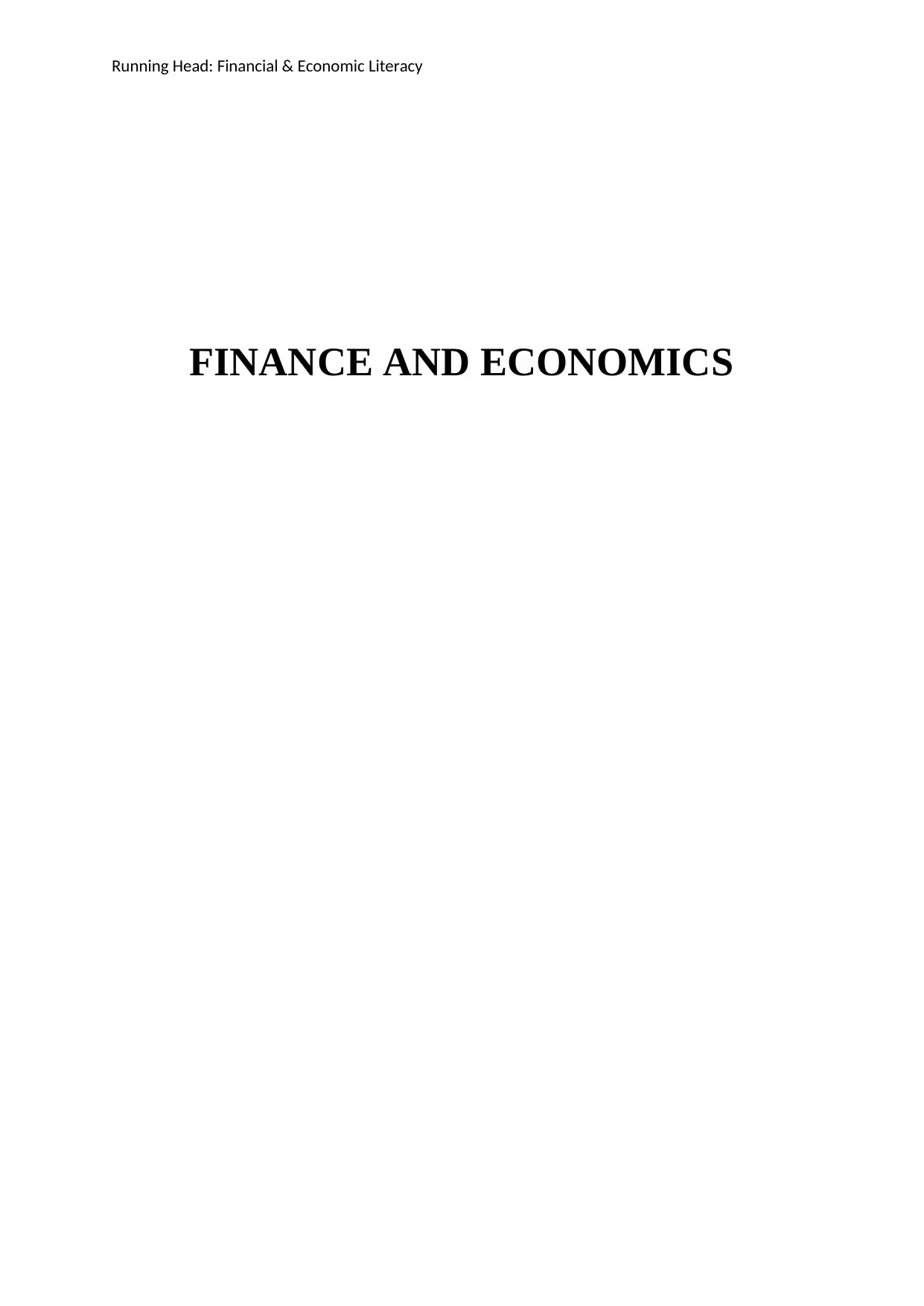
Running Head: Financial & Economic Literacy
FINANCE AND ECONOMICS
FINANCE AND ECONOMICS
Paraphrase This Document
Need a fresh take? Get an instant paraphrase of this document with our AI Paraphraser
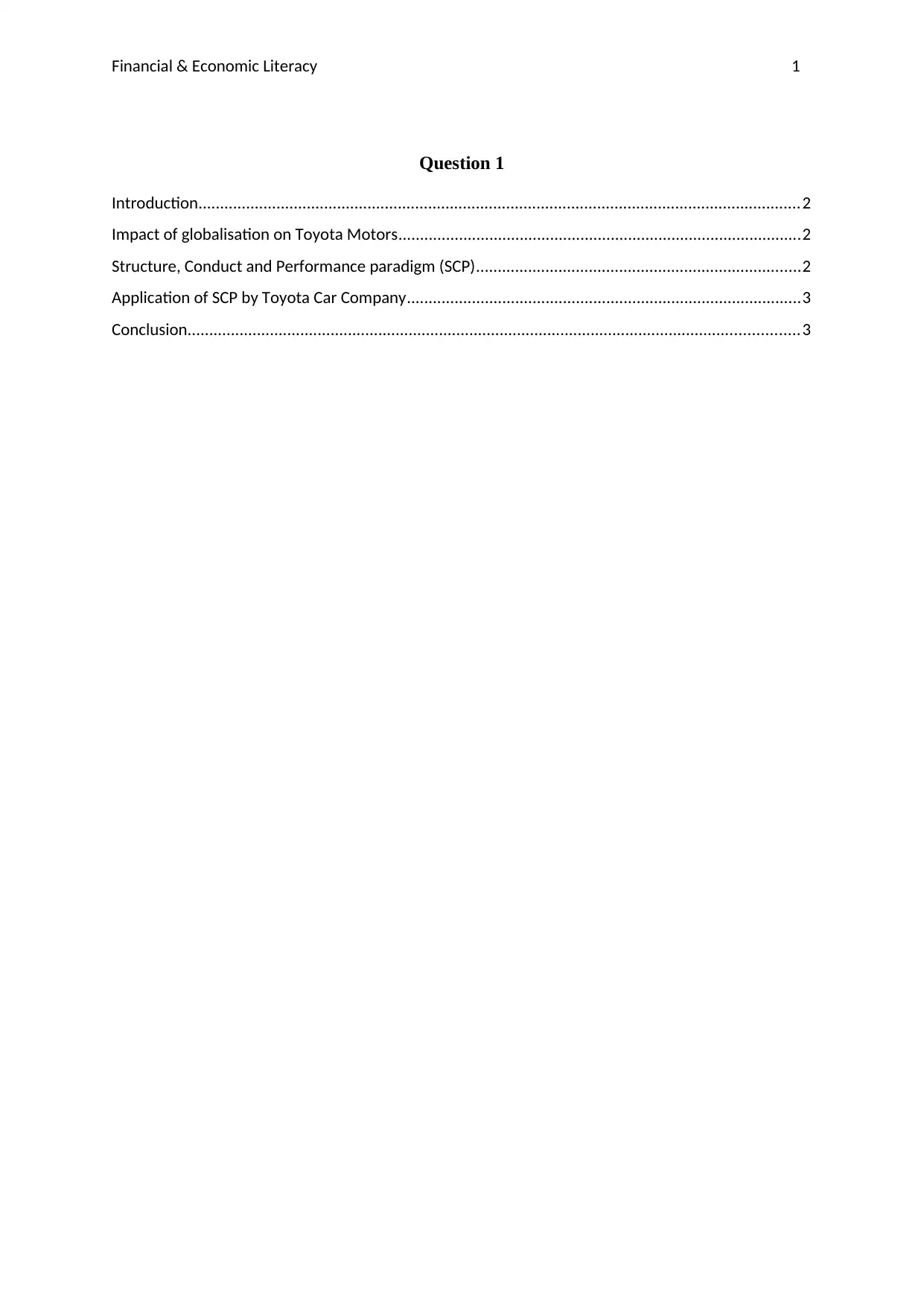
Financial & Economic Literacy 1
Question 1
Introduction...........................................................................................................................................2
Impact of globalisation on Toyota Motors.............................................................................................2
Structure, Conduct and Performance paradigm (SCP)...........................................................................2
Application of SCP by Toyota Car Company...........................................................................................3
Conclusion.............................................................................................................................................3
Question 1
Introduction...........................................................................................................................................2
Impact of globalisation on Toyota Motors.............................................................................................2
Structure, Conduct and Performance paradigm (SCP)...........................................................................2
Application of SCP by Toyota Car Company...........................................................................................3
Conclusion.............................................................................................................................................3
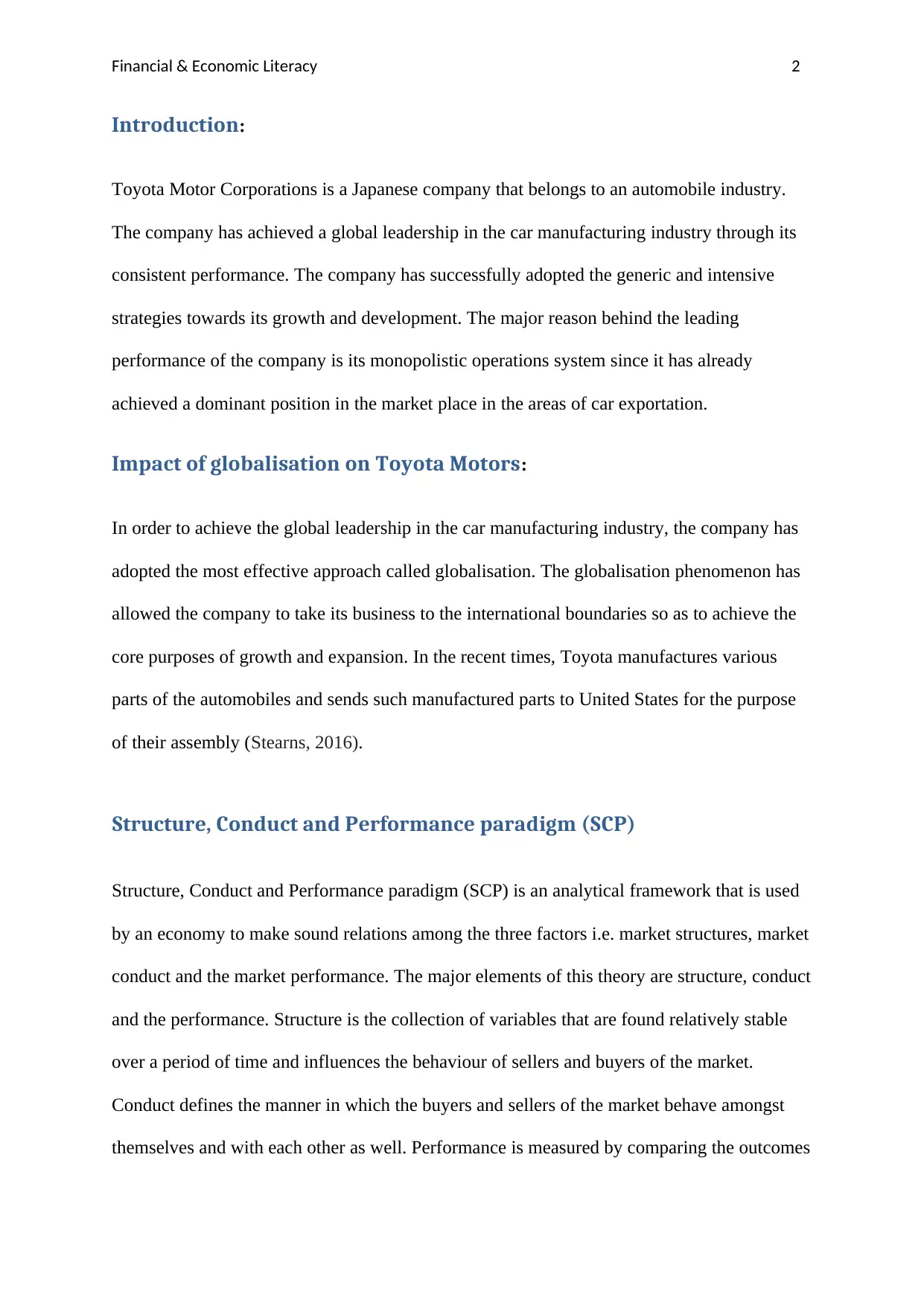
Financial & Economic Literacy 2
Introduction:
Toyota Motor Corporations is a Japanese company that belongs to an automobile industry.
The company has achieved a global leadership in the car manufacturing industry through its
consistent performance. The company has successfully adopted the generic and intensive
strategies towards its growth and development. The major reason behind the leading
performance of the company is its monopolistic operations system since it has already
achieved a dominant position in the market place in the areas of car exportation.
Impact of globalisation on Toyota Motors:
In order to achieve the global leadership in the car manufacturing industry, the company has
adopted the most effective approach called globalisation. The globalisation phenomenon has
allowed the company to take its business to the international boundaries so as to achieve the
core purposes of growth and expansion. In the recent times, Toyota manufactures various
parts of the automobiles and sends such manufactured parts to United States for the purpose
of their assembly (Stearns, 2016).
Structure, Conduct and Performance paradigm (SCP)
Structure, Conduct and Performance paradigm (SCP) is an analytical framework that is used
by an economy to make sound relations among the three factors i.e. market structures, market
conduct and the market performance. The major elements of this theory are structure, conduct
and the performance. Structure is the collection of variables that are found relatively stable
over a period of time and influences the behaviour of sellers and buyers of the market.
Conduct defines the manner in which the buyers and sellers of the market behave amongst
themselves and with each other as well. Performance is measured by comparing the outcomes
Introduction:
Toyota Motor Corporations is a Japanese company that belongs to an automobile industry.
The company has achieved a global leadership in the car manufacturing industry through its
consistent performance. The company has successfully adopted the generic and intensive
strategies towards its growth and development. The major reason behind the leading
performance of the company is its monopolistic operations system since it has already
achieved a dominant position in the market place in the areas of car exportation.
Impact of globalisation on Toyota Motors:
In order to achieve the global leadership in the car manufacturing industry, the company has
adopted the most effective approach called globalisation. The globalisation phenomenon has
allowed the company to take its business to the international boundaries so as to achieve the
core purposes of growth and expansion. In the recent times, Toyota manufactures various
parts of the automobiles and sends such manufactured parts to United States for the purpose
of their assembly (Stearns, 2016).
Structure, Conduct and Performance paradigm (SCP)
Structure, Conduct and Performance paradigm (SCP) is an analytical framework that is used
by an economy to make sound relations among the three factors i.e. market structures, market
conduct and the market performance. The major elements of this theory are structure, conduct
and the performance. Structure is the collection of variables that are found relatively stable
over a period of time and influences the behaviour of sellers and buyers of the market.
Conduct defines the manner in which the buyers and sellers of the market behave amongst
themselves and with each other as well. Performance is measured by comparing the outcomes
⊘ This is a preview!⊘
Do you want full access?
Subscribe today to unlock all pages.

Trusted by 1+ million students worldwide
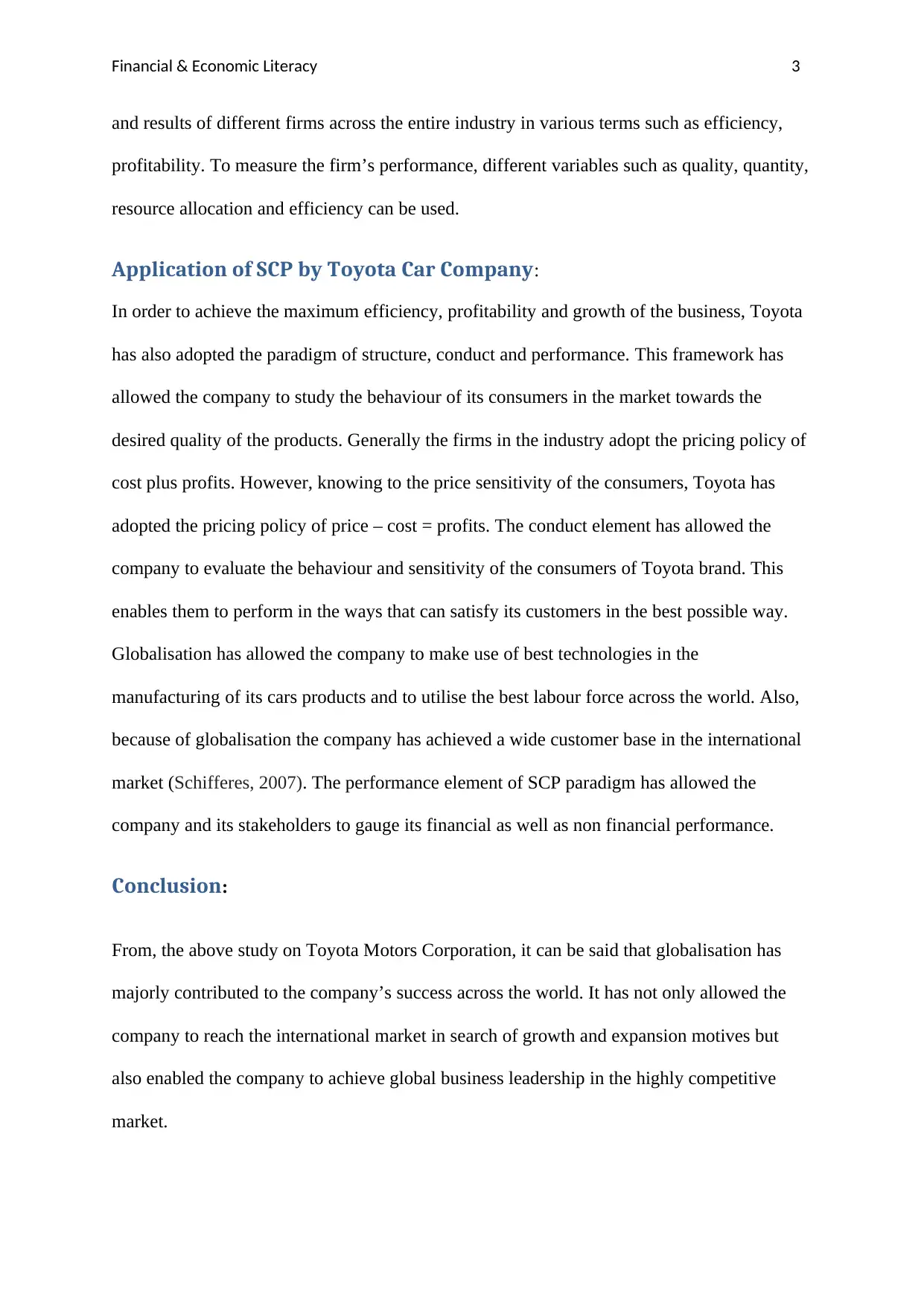
Financial & Economic Literacy 3
and results of different firms across the entire industry in various terms such as efficiency,
profitability. To measure the firm’s performance, different variables such as quality, quantity,
resource allocation and efficiency can be used.
Application of SCP by Toyota Car Company:
In order to achieve the maximum efficiency, profitability and growth of the business, Toyota
has also adopted the paradigm of structure, conduct and performance. This framework has
allowed the company to study the behaviour of its consumers in the market towards the
desired quality of the products. Generally the firms in the industry adopt the pricing policy of
cost plus profits. However, knowing to the price sensitivity of the consumers, Toyota has
adopted the pricing policy of price – cost = profits. The conduct element has allowed the
company to evaluate the behaviour and sensitivity of the consumers of Toyota brand. This
enables them to perform in the ways that can satisfy its customers in the best possible way.
Globalisation has allowed the company to make use of best technologies in the
manufacturing of its cars products and to utilise the best labour force across the world. Also,
because of globalisation the company has achieved a wide customer base in the international
market (Schifferes, 2007). The performance element of SCP paradigm has allowed the
company and its stakeholders to gauge its financial as well as non financial performance.
Conclusion:
From, the above study on Toyota Motors Corporation, it can be said that globalisation has
majorly contributed to the company’s success across the world. It has not only allowed the
company to reach the international market in search of growth and expansion motives but
also enabled the company to achieve global business leadership in the highly competitive
market.
and results of different firms across the entire industry in various terms such as efficiency,
profitability. To measure the firm’s performance, different variables such as quality, quantity,
resource allocation and efficiency can be used.
Application of SCP by Toyota Car Company:
In order to achieve the maximum efficiency, profitability and growth of the business, Toyota
has also adopted the paradigm of structure, conduct and performance. This framework has
allowed the company to study the behaviour of its consumers in the market towards the
desired quality of the products. Generally the firms in the industry adopt the pricing policy of
cost plus profits. However, knowing to the price sensitivity of the consumers, Toyota has
adopted the pricing policy of price – cost = profits. The conduct element has allowed the
company to evaluate the behaviour and sensitivity of the consumers of Toyota brand. This
enables them to perform in the ways that can satisfy its customers in the best possible way.
Globalisation has allowed the company to make use of best technologies in the
manufacturing of its cars products and to utilise the best labour force across the world. Also,
because of globalisation the company has achieved a wide customer base in the international
market (Schifferes, 2007). The performance element of SCP paradigm has allowed the
company and its stakeholders to gauge its financial as well as non financial performance.
Conclusion:
From, the above study on Toyota Motors Corporation, it can be said that globalisation has
majorly contributed to the company’s success across the world. It has not only allowed the
company to reach the international market in search of growth and expansion motives but
also enabled the company to achieve global business leadership in the highly competitive
market.
Paraphrase This Document
Need a fresh take? Get an instant paraphrase of this document with our AI Paraphraser
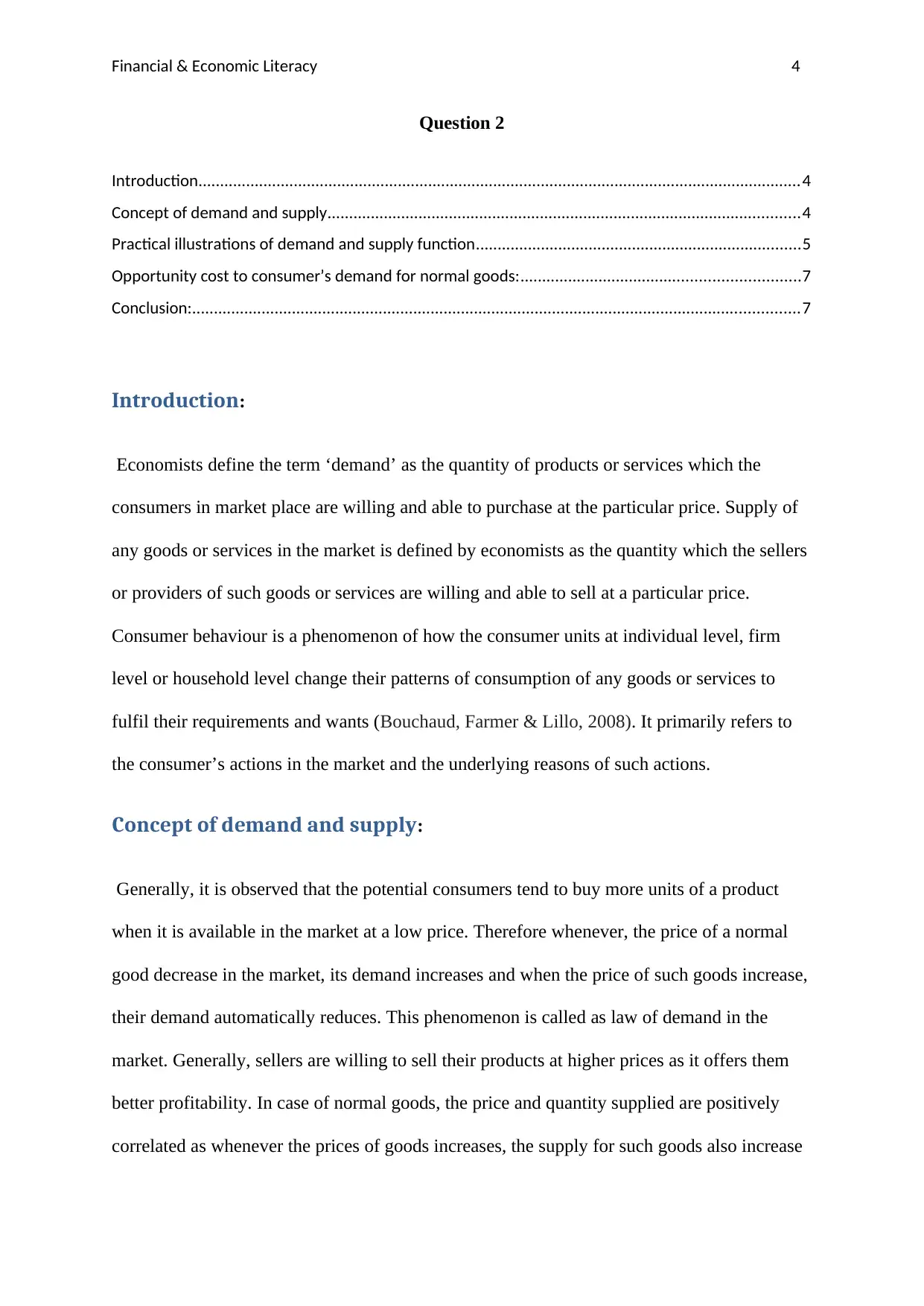
Financial & Economic Literacy 4
Question 2
Introduction...........................................................................................................................................4
Concept of demand and supply.............................................................................................................4
Practical illustrations of demand and supply function...........................................................................5
Opportunity cost to consumer’s demand for normal goods:................................................................7
Conclusion:............................................................................................................................................7
Introduction:
Economists define the term ‘demand’ as the quantity of products or services which the
consumers in market place are willing and able to purchase at the particular price. Supply of
any goods or services in the market is defined by economists as the quantity which the sellers
or providers of such goods or services are willing and able to sell at a particular price.
Consumer behaviour is a phenomenon of how the consumer units at individual level, firm
level or household level change their patterns of consumption of any goods or services to
fulfil their requirements and wants (Bouchaud, Farmer & Lillo, 2008). It primarily refers to
the consumer’s actions in the market and the underlying reasons of such actions.
Concept of demand and supply:
Generally, it is observed that the potential consumers tend to buy more units of a product
when it is available in the market at a low price. Therefore whenever, the price of a normal
good decrease in the market, its demand increases and when the price of such goods increase,
their demand automatically reduces. This phenomenon is called as law of demand in the
market. Generally, sellers are willing to sell their products at higher prices as it offers them
better profitability. In case of normal goods, the price and quantity supplied are positively
correlated as whenever the prices of goods increases, the supply for such goods also increase
Question 2
Introduction...........................................................................................................................................4
Concept of demand and supply.............................................................................................................4
Practical illustrations of demand and supply function...........................................................................5
Opportunity cost to consumer’s demand for normal goods:................................................................7
Conclusion:............................................................................................................................................7
Introduction:
Economists define the term ‘demand’ as the quantity of products or services which the
consumers in market place are willing and able to purchase at the particular price. Supply of
any goods or services in the market is defined by economists as the quantity which the sellers
or providers of such goods or services are willing and able to sell at a particular price.
Consumer behaviour is a phenomenon of how the consumer units at individual level, firm
level or household level change their patterns of consumption of any goods or services to
fulfil their requirements and wants (Bouchaud, Farmer & Lillo, 2008). It primarily refers to
the consumer’s actions in the market and the underlying reasons of such actions.
Concept of demand and supply:
Generally, it is observed that the potential consumers tend to buy more units of a product
when it is available in the market at a low price. Therefore whenever, the price of a normal
good decrease in the market, its demand increases and when the price of such goods increase,
their demand automatically reduces. This phenomenon is called as law of demand in the
market. Generally, sellers are willing to sell their products at higher prices as it offers them
better profitability. In case of normal goods, the price and quantity supplied are positively
correlated as whenever the prices of goods increases, the supply for such goods also increase
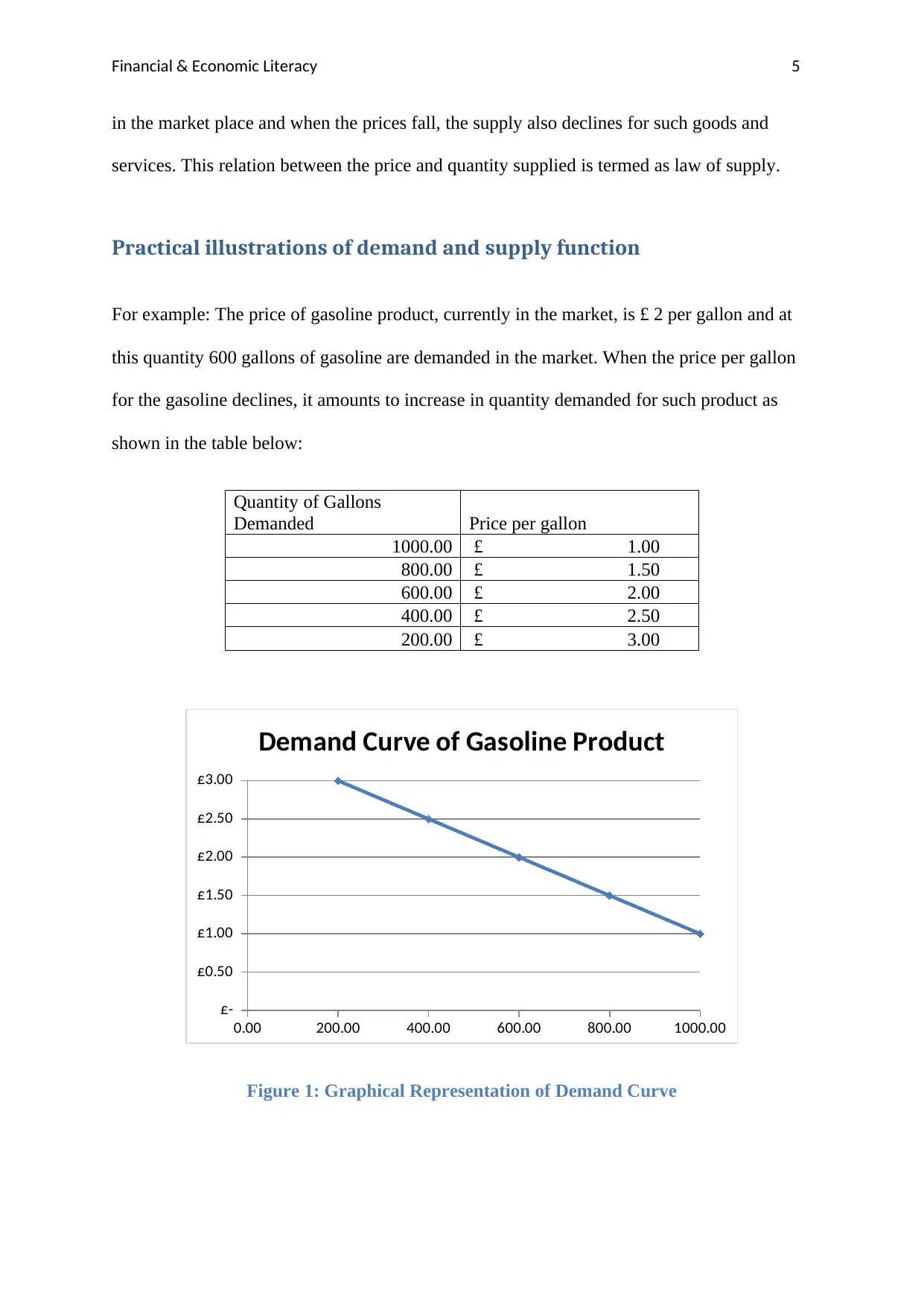
Financial & Economic Literacy 5
in the market place and when the prices fall, the supply also declines for such goods and
services. This relation between the price and quantity supplied is termed as law of supply.
Practical illustrations of demand and supply function
For example: The price of gasoline product, currently in the market, is £ 2 per gallon and at
this quantity 600 gallons of gasoline are demanded in the market. When the price per gallon
for the gasoline declines, it amounts to increase in quantity demanded for such product as
shown in the table below:
Quantity of Gallons
Demanded Price per gallon
1000.00 £ 1.00
800.00 £ 1.50
600.00 £ 2.00
400.00 £ 2.50
200.00 £ 3.00
0.00 200.00 400.00 600.00 800.00 1000.00
£-
£0.50
£1.00
£1.50
£2.00
£2.50
£3.00
Demand Curve of Gasoline Product
Figure 1: Graphical Representation of Demand Curve
in the market place and when the prices fall, the supply also declines for such goods and
services. This relation between the price and quantity supplied is termed as law of supply.
Practical illustrations of demand and supply function
For example: The price of gasoline product, currently in the market, is £ 2 per gallon and at
this quantity 600 gallons of gasoline are demanded in the market. When the price per gallon
for the gasoline declines, it amounts to increase in quantity demanded for such product as
shown in the table below:
Quantity of Gallons
Demanded Price per gallon
1000.00 £ 1.00
800.00 £ 1.50
600.00 £ 2.00
400.00 £ 2.50
200.00 £ 3.00
0.00 200.00 400.00 600.00 800.00 1000.00
£-
£0.50
£1.00
£1.50
£2.00
£2.50
£3.00
Demand Curve of Gasoline Product
Figure 1: Graphical Representation of Demand Curve
⊘ This is a preview!⊘
Do you want full access?
Subscribe today to unlock all pages.

Trusted by 1+ million students worldwide
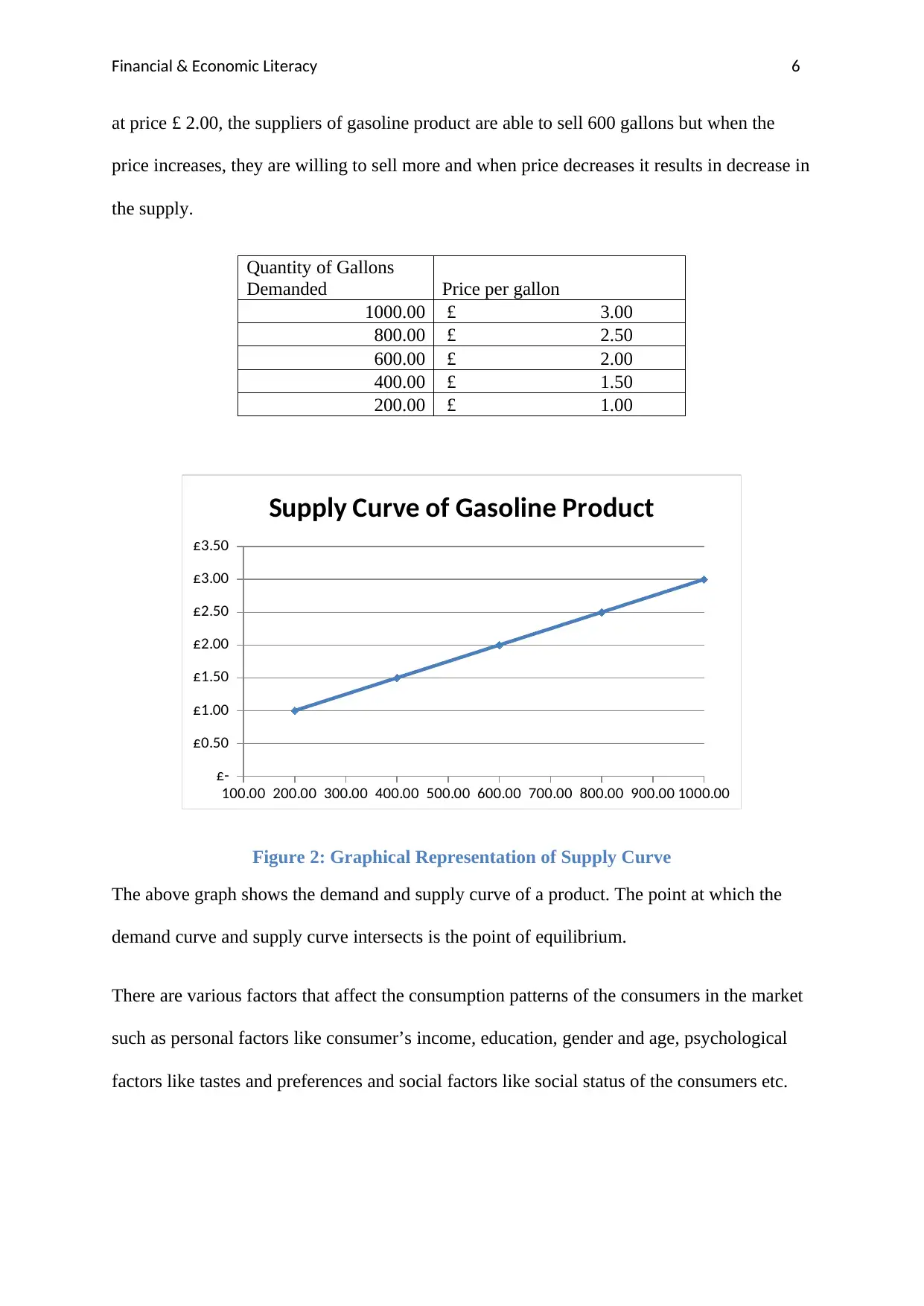
Financial & Economic Literacy 6
at price £ 2.00, the suppliers of gasoline product are able to sell 600 gallons but when the
price increases, they are willing to sell more and when price decreases it results in decrease in
the supply.
Quantity of Gallons
Demanded Price per gallon
1000.00 £ 3.00
800.00 £ 2.50
600.00 £ 2.00
400.00 £ 1.50
200.00 £ 1.00
100.00 200.00 300.00 400.00 500.00 600.00 700.00 800.00 900.00 1000.00
£-
£0.50
£1.00
£1.50
£2.00
£2.50
£3.00
£3.50
Supply Curve of Gasoline Product
Figure 2: Graphical Representation of Supply Curve
The above graph shows the demand and supply curve of a product. The point at which the
demand curve and supply curve intersects is the point of equilibrium.
There are various factors that affect the consumption patterns of the consumers in the market
such as personal factors like consumer’s income, education, gender and age, psychological
factors like tastes and preferences and social factors like social status of the consumers etc.
at price £ 2.00, the suppliers of gasoline product are able to sell 600 gallons but when the
price increases, they are willing to sell more and when price decreases it results in decrease in
the supply.
Quantity of Gallons
Demanded Price per gallon
1000.00 £ 3.00
800.00 £ 2.50
600.00 £ 2.00
400.00 £ 1.50
200.00 £ 1.00
100.00 200.00 300.00 400.00 500.00 600.00 700.00 800.00 900.00 1000.00
£-
£0.50
£1.00
£1.50
£2.00
£2.50
£3.00
£3.50
Supply Curve of Gasoline Product
Figure 2: Graphical Representation of Supply Curve
The above graph shows the demand and supply curve of a product. The point at which the
demand curve and supply curve intersects is the point of equilibrium.
There are various factors that affect the consumption patterns of the consumers in the market
such as personal factors like consumer’s income, education, gender and age, psychological
factors like tastes and preferences and social factors like social status of the consumers etc.
Paraphrase This Document
Need a fresh take? Get an instant paraphrase of this document with our AI Paraphraser
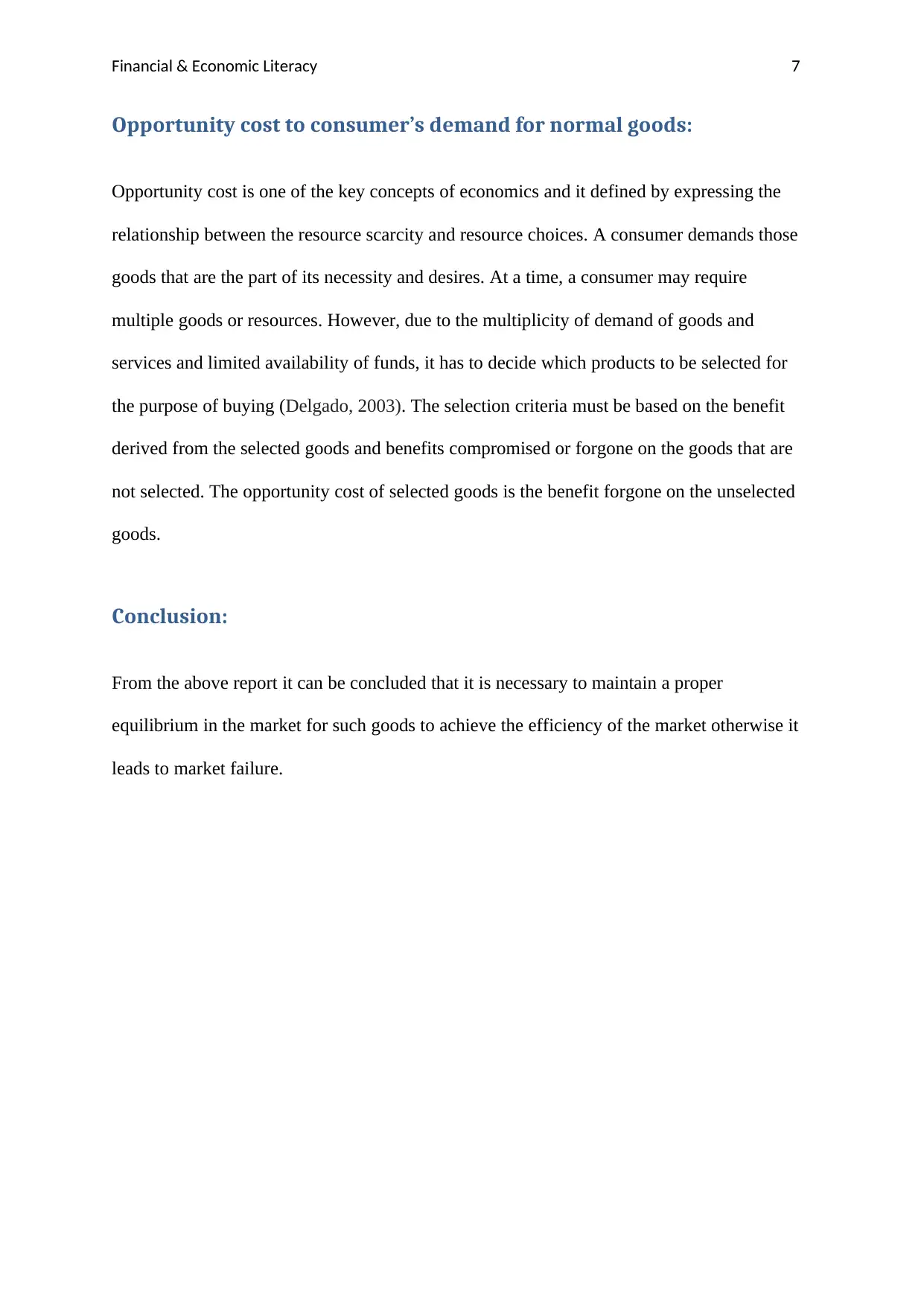
Financial & Economic Literacy 7
Opportunity cost to consumer’s demand for normal goods:
Opportunity cost is one of the key concepts of economics and it defined by expressing the
relationship between the resource scarcity and resource choices. A consumer demands those
goods that are the part of its necessity and desires. At a time, a consumer may require
multiple goods or resources. However, due to the multiplicity of demand of goods and
services and limited availability of funds, it has to decide which products to be selected for
the purpose of buying (Delgado, 2003). The selection criteria must be based on the benefit
derived from the selected goods and benefits compromised or forgone on the goods that are
not selected. The opportunity cost of selected goods is the benefit forgone on the unselected
goods.
Conclusion:
From the above report it can be concluded that it is necessary to maintain a proper
equilibrium in the market for such goods to achieve the efficiency of the market otherwise it
leads to market failure.
Opportunity cost to consumer’s demand for normal goods:
Opportunity cost is one of the key concepts of economics and it defined by expressing the
relationship between the resource scarcity and resource choices. A consumer demands those
goods that are the part of its necessity and desires. At a time, a consumer may require
multiple goods or resources. However, due to the multiplicity of demand of goods and
services and limited availability of funds, it has to decide which products to be selected for
the purpose of buying (Delgado, 2003). The selection criteria must be based on the benefit
derived from the selected goods and benefits compromised or forgone on the goods that are
not selected. The opportunity cost of selected goods is the benefit forgone on the unselected
goods.
Conclusion:
From the above report it can be concluded that it is necessary to maintain a proper
equilibrium in the market for such goods to achieve the efficiency of the market otherwise it
leads to market failure.
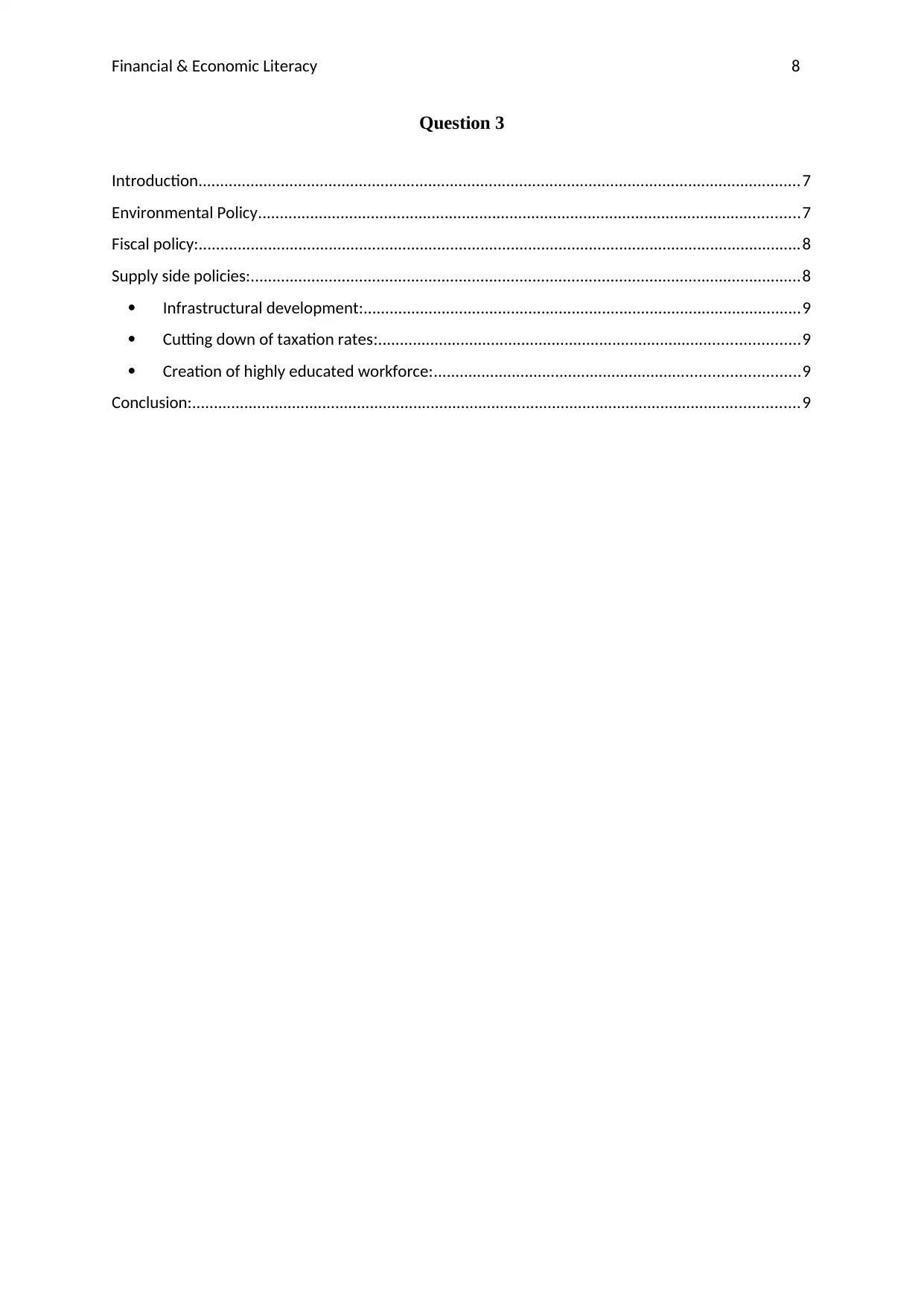
Financial & Economic Literacy 8
Question 3
Introduction...........................................................................................................................................7
Environmental Policy.............................................................................................................................7
Fiscal policy:...........................................................................................................................................8
Supply side policies:...............................................................................................................................8
Infrastructural development:.....................................................................................................9
Cutting down of taxation rates:.................................................................................................9
Creation of highly educated workforce:....................................................................................9
Conclusion:............................................................................................................................................9
Question 3
Introduction...........................................................................................................................................7
Environmental Policy.............................................................................................................................7
Fiscal policy:...........................................................................................................................................8
Supply side policies:...............................................................................................................................8
Infrastructural development:.....................................................................................................9
Cutting down of taxation rates:.................................................................................................9
Creation of highly educated workforce:....................................................................................9
Conclusion:............................................................................................................................................9
⊘ This is a preview!⊘
Do you want full access?
Subscribe today to unlock all pages.

Trusted by 1+ million students worldwide
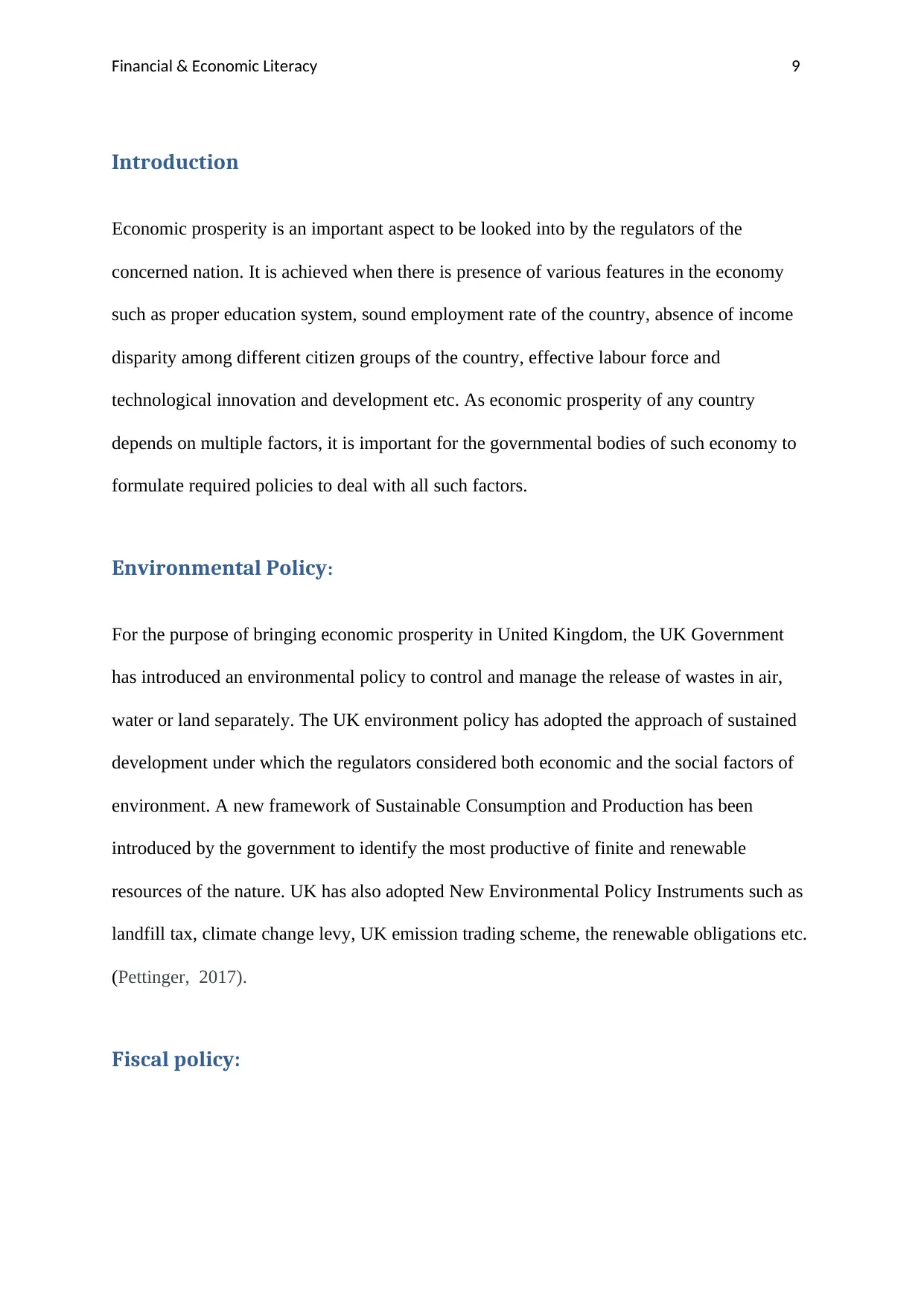
Financial & Economic Literacy 9
Introduction
Economic prosperity is an important aspect to be looked into by the regulators of the
concerned nation. It is achieved when there is presence of various features in the economy
such as proper education system, sound employment rate of the country, absence of income
disparity among different citizen groups of the country, effective labour force and
technological innovation and development etc. As economic prosperity of any country
depends on multiple factors, it is important for the governmental bodies of such economy to
formulate required policies to deal with all such factors.
Environmental Policy:
For the purpose of bringing economic prosperity in United Kingdom, the UK Government
has introduced an environmental policy to control and manage the release of wastes in air,
water or land separately. The UK environment policy has adopted the approach of sustained
development under which the regulators considered both economic and the social factors of
environment. A new framework of Sustainable Consumption and Production has been
introduced by the government to identify the most productive of finite and renewable
resources of the nature. UK has also adopted New Environmental Policy Instruments such as
landfill tax, climate change levy, UK emission trading scheme, the renewable obligations etc.
(Pettinger, 2017).
Fiscal policy:
Introduction
Economic prosperity is an important aspect to be looked into by the regulators of the
concerned nation. It is achieved when there is presence of various features in the economy
such as proper education system, sound employment rate of the country, absence of income
disparity among different citizen groups of the country, effective labour force and
technological innovation and development etc. As economic prosperity of any country
depends on multiple factors, it is important for the governmental bodies of such economy to
formulate required policies to deal with all such factors.
Environmental Policy:
For the purpose of bringing economic prosperity in United Kingdom, the UK Government
has introduced an environmental policy to control and manage the release of wastes in air,
water or land separately. The UK environment policy has adopted the approach of sustained
development under which the regulators considered both economic and the social factors of
environment. A new framework of Sustainable Consumption and Production has been
introduced by the government to identify the most productive of finite and renewable
resources of the nature. UK has also adopted New Environmental Policy Instruments such as
landfill tax, climate change levy, UK emission trading scheme, the renewable obligations etc.
(Pettinger, 2017).
Fiscal policy:
Paraphrase This Document
Need a fresh take? Get an instant paraphrase of this document with our AI Paraphraser
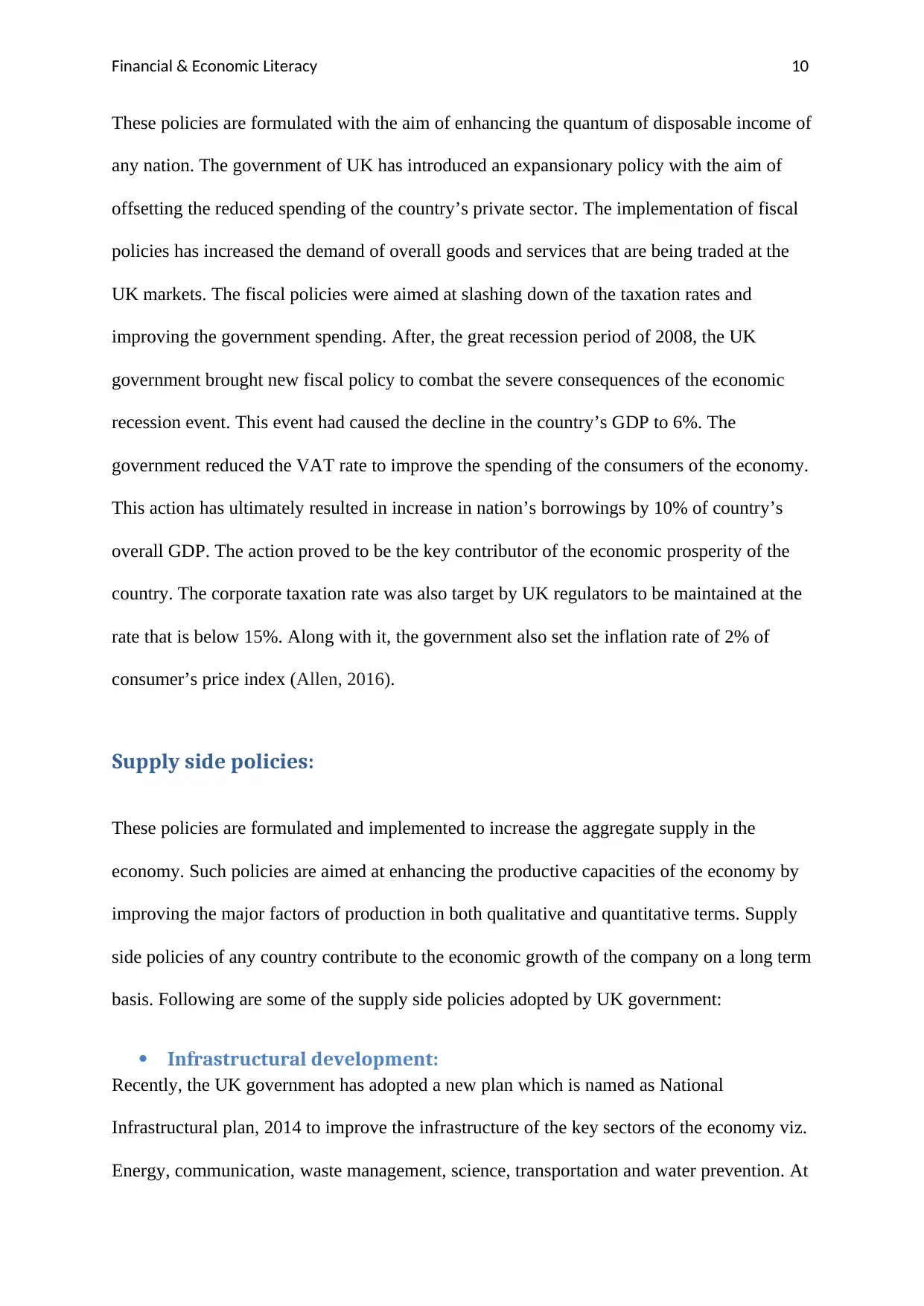
Financial & Economic Literacy 10
These policies are formulated with the aim of enhancing the quantum of disposable income of
any nation. The government of UK has introduced an expansionary policy with the aim of
offsetting the reduced spending of the country’s private sector. The implementation of fiscal
policies has increased the demand of overall goods and services that are being traded at the
UK markets. The fiscal policies were aimed at slashing down of the taxation rates and
improving the government spending. After, the great recession period of 2008, the UK
government brought new fiscal policy to combat the severe consequences of the economic
recession event. This event had caused the decline in the country’s GDP to 6%. The
government reduced the VAT rate to improve the spending of the consumers of the economy.
This action has ultimately resulted in increase in nation’s borrowings by 10% of country’s
overall GDP. The action proved to be the key contributor of the economic prosperity of the
country. The corporate taxation rate was also target by UK regulators to be maintained at the
rate that is below 15%. Along with it, the government also set the inflation rate of 2% of
consumer’s price index (Allen, 2016).
Supply side policies:
These policies are formulated and implemented to increase the aggregate supply in the
economy. Such policies are aimed at enhancing the productive capacities of the economy by
improving the major factors of production in both qualitative and quantitative terms. Supply
side policies of any country contribute to the economic growth of the company on a long term
basis. Following are some of the supply side policies adopted by UK government:
Infrastructural development:
Recently, the UK government has adopted a new plan which is named as National
Infrastructural plan, 2014 to improve the infrastructure of the key sectors of the economy viz.
Energy, communication, waste management, science, transportation and water prevention. At
These policies are formulated with the aim of enhancing the quantum of disposable income of
any nation. The government of UK has introduced an expansionary policy with the aim of
offsetting the reduced spending of the country’s private sector. The implementation of fiscal
policies has increased the demand of overall goods and services that are being traded at the
UK markets. The fiscal policies were aimed at slashing down of the taxation rates and
improving the government spending. After, the great recession period of 2008, the UK
government brought new fiscal policy to combat the severe consequences of the economic
recession event. This event had caused the decline in the country’s GDP to 6%. The
government reduced the VAT rate to improve the spending of the consumers of the economy.
This action has ultimately resulted in increase in nation’s borrowings by 10% of country’s
overall GDP. The action proved to be the key contributor of the economic prosperity of the
country. The corporate taxation rate was also target by UK regulators to be maintained at the
rate that is below 15%. Along with it, the government also set the inflation rate of 2% of
consumer’s price index (Allen, 2016).
Supply side policies:
These policies are formulated and implemented to increase the aggregate supply in the
economy. Such policies are aimed at enhancing the productive capacities of the economy by
improving the major factors of production in both qualitative and quantitative terms. Supply
side policies of any country contribute to the economic growth of the company on a long term
basis. Following are some of the supply side policies adopted by UK government:
Infrastructural development:
Recently, the UK government has adopted a new plan which is named as National
Infrastructural plan, 2014 to improve the infrastructure of the key sectors of the economy viz.
Energy, communication, waste management, science, transportation and water prevention. At
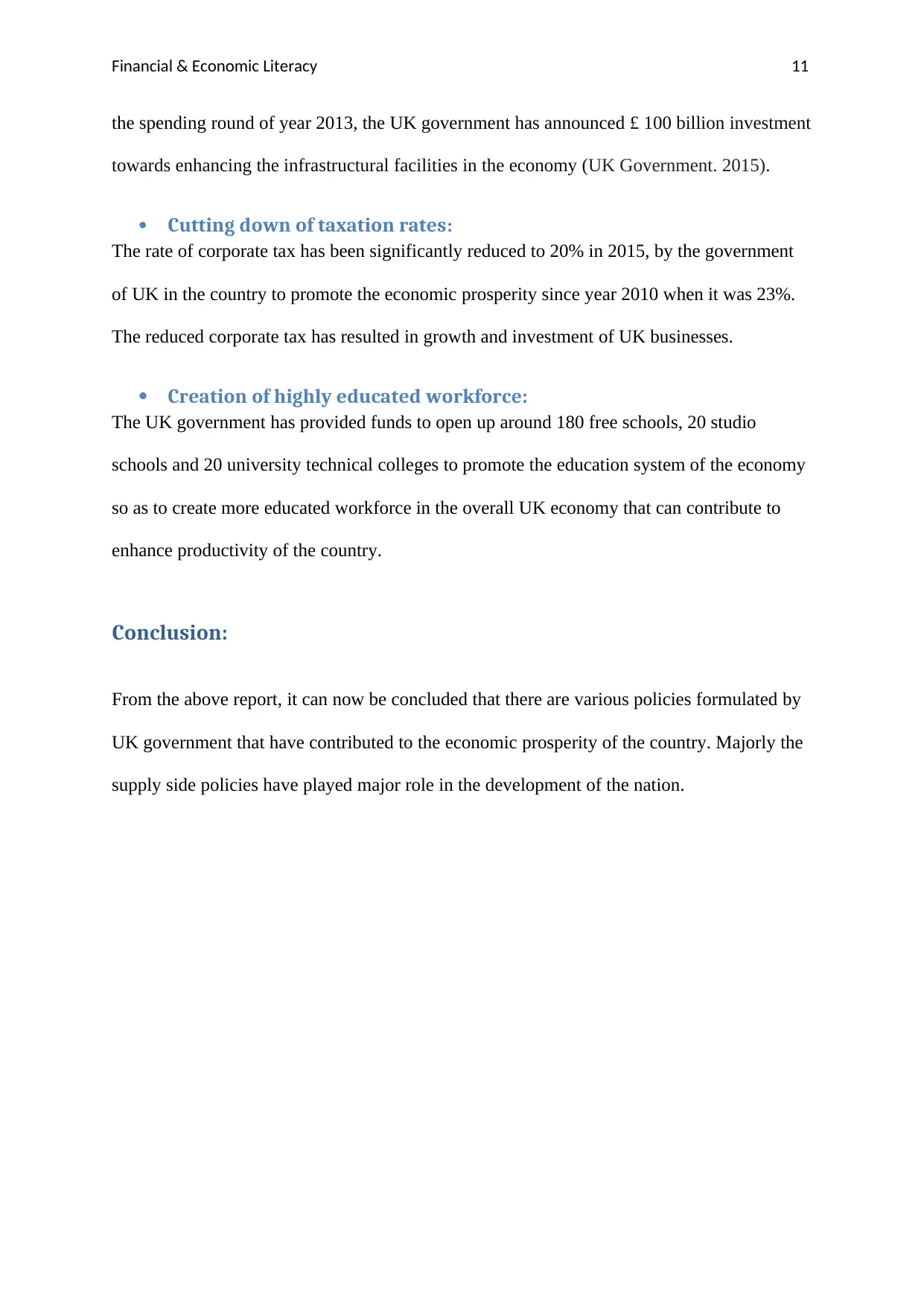
Financial & Economic Literacy 11
the spending round of year 2013, the UK government has announced £ 100 billion investment
towards enhancing the infrastructural facilities in the economy (UK Government. 2015).
Cutting down of taxation rates:
The rate of corporate tax has been significantly reduced to 20% in 2015, by the government
of UK in the country to promote the economic prosperity since year 2010 when it was 23%.
The reduced corporate tax has resulted in growth and investment of UK businesses.
Creation of highly educated workforce:
The UK government has provided funds to open up around 180 free schools, 20 studio
schools and 20 university technical colleges to promote the education system of the economy
so as to create more educated workforce in the overall UK economy that can contribute to
enhance productivity of the country.
Conclusion:
From the above report, it can now be concluded that there are various policies formulated by
UK government that have contributed to the economic prosperity of the country. Majorly the
supply side policies have played major role in the development of the nation.
the spending round of year 2013, the UK government has announced £ 100 billion investment
towards enhancing the infrastructural facilities in the economy (UK Government. 2015).
Cutting down of taxation rates:
The rate of corporate tax has been significantly reduced to 20% in 2015, by the government
of UK in the country to promote the economic prosperity since year 2010 when it was 23%.
The reduced corporate tax has resulted in growth and investment of UK businesses.
Creation of highly educated workforce:
The UK government has provided funds to open up around 180 free schools, 20 studio
schools and 20 university technical colleges to promote the education system of the economy
so as to create more educated workforce in the overall UK economy that can contribute to
enhance productivity of the country.
Conclusion:
From the above report, it can now be concluded that there are various policies formulated by
UK government that have contributed to the economic prosperity of the country. Majorly the
supply side policies have played major role in the development of the nation.
⊘ This is a preview!⊘
Do you want full access?
Subscribe today to unlock all pages.

Trusted by 1+ million students worldwide
1 out of 21
Related Documents
Your All-in-One AI-Powered Toolkit for Academic Success.
+13062052269
info@desklib.com
Available 24*7 on WhatsApp / Email
![[object Object]](/_next/static/media/star-bottom.7253800d.svg)
Unlock your academic potential
Copyright © 2020–2025 A2Z Services. All Rights Reserved. Developed and managed by ZUCOL.





